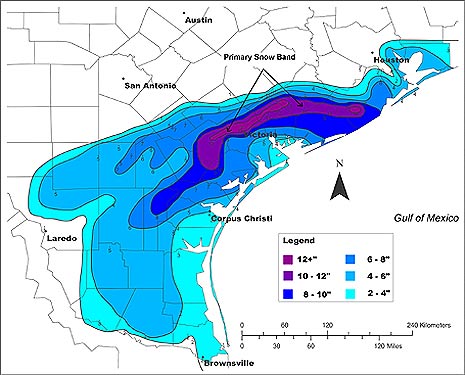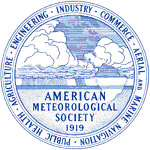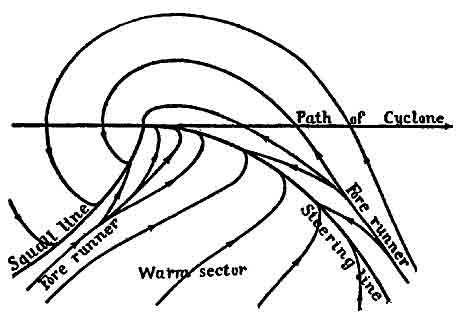Discoveries about the atmospheres of other planets have been closely linked to insights about our own. When a young Carl Sagan confirmed the effect of high CO2 concentrations—a runaway greenhouse effect—on Venus in 1960, for instance, he helped intensify interest in potential anthropogenic warming on Earth.
Conversely, climate models, and now mesoscale weather models such as the WRF, developed for Earthly forecasting, are applied to modeling conditions elsewhere. At the AMS’s first Symposium on Planetary Atmospheres in Atlanta, Scot Rafkin of the Southwest Research Institute will present, “Application of Mesoscale Atmospheric Models to Mars Missions” (Thursday, 11 a.m., B211). He’ll discuss how terrestrial weather models helped engineers anticipate landing conditions on the Red Planet as well as
When Wars Are Hot, Crops Are Not
As if it weren’t enough to keep track of arms trafficking, political mischief, and ethnic tensions around the world, now international aid agencies and national security watchdogs are told they have to watch temperatures, too. An article last week in the Proceedings of the National Academy of Sciences links warm years in West Africa with major civil conflicts (defined to include battle deaths of at least 1,000).
The authors, led by Marshall Burke, an economist at the University of California, Berkeley, show that temperature has a stronger relationship to internal strife than typical indicators like per capita income or type of political regime. They predict more conflict in the region as the world warms.
Other studies, noting the centrality of rain-fed agriculture in West Africa, have identified precipitation as a regional security indicator. However, the new study shows that temperature may be an even better
Magic Numbers
The tangibility of numbers makes them an ideal tool for marketing. Telling drivers to slow down isn’t nearly as vivid as telling them that “55 saves lives,” (though we later learned that 65 m.p.h. apparently saves lives just as well). Football fans have probably seen ads for the NFL’s “Play 60” campaign that encourages children to get a daily hour of exercise, and there is a similar program for K-5 teachers and their students called “Take 10.” Numerous other examples abound.
Not surprisingly, climate change activists have discovered the allure of numbers, too. A recent worldwide demonstration highlighted
Walking through Problems of Urban Air Quality
Doctors tell us to get more exercise—walking is as good for the body as for the environment. But is it healthy to take a walk in neighborhoods where walking is actually practical? If Vancouver, British Columbia, is representative of most urban areas, then the answer is “no.”
A recent study in Environmental Health Perspectives found that areas that rate highly for both walkability and air quality house only about 2% of the city’s population (they tend to be high-income regions a few miles from downtown).
The nitric oxide and the resulting ozone from auto emissions tend to concentrate in different parts of the city: nitric acid is more pervasive downtown, because ozone takes longer to form and has often drifted from its city sources before reaching its greatest concentrations in the suburbs.
The authors suggest that living in high-rises have an unintended health benefit: they are usually in a walkable environment and also allow most residents to spend much of their time farther away from street-level emissions.
These roadway air quality problems can be quite serious. A new study of the Los Angeles area connects asthma in children with proximity to heavy-traffic areas, with 9% of all childhood asthma cases in Long Beach and 6% in Riverside attributable to living within 75 meters of a major road.
“The impact of roadway proximity on the overall burden of asthma-related illness is remarkable,” said principal investigator Rob McConnell of the University of Southern California. “Air pollution is a more important contributor to the burden of childhood asthma than is generally recognized, especially to more severe episodes requiring visits to a clinic or emergency room.”
The study in the American Journal of Public Health also highlighted the impact of shipping in the region—the Los Angeles-Long Beach port is the largest in the United States—by estimating that 21% of asthma-related bronchitis episodes in Long Beach (about 1,400 cases total) and 8% in Riverside (3,400 cases) were caused by nitrogen dioxide emitted by ships.
If the air is the problem, then meteorology may offer some of the solutions. In a poster to be presented Monday (2:30 pm; Environment and Health Symposium) at the AMS Annual Meeting, David Quesada will report on correlations between weather—including humidity, rain, and winds—and asthma in Miami, Florida, where residents suffer above-average asthma incidence.
With pollen and particulate data in hand, the project may identify ways to help residents live well in an urban environment—without necessarily building more high-rises.
Making a MoPED with Big Rigs
Speaking of the future of weather information along transportation corridors, one of the presenters in the Weather and Transportation sessions Monday (1:30 p.m.) is Brian Bell of Global Science & Technology, an exhibitor at the upcoming Annual Meeting. His topic is a project that will show NOAA how well the commercial trucking fleet can serve as an automated system to gather and report weather information on the road, just as airliners do in the air.
Last year at the AMS meeting GS&T demonstrated a novel mobile weather station with an inflatable satellite dish for easy deployment. But this fall the West Virginia company won the 9-month contract from NOAA to build the Mobile Platform Environmental Data observation network (MoPED). To learn more about the project before the Annual Meeting, see this article from the Times West Virginian.
Are Smarter, Safer Roads Good for Us?
It’s not often you hear that congested traffic arteries are good for you. But this is what you find in a thought-provoking recent Op-Ed in the Wall Street Journal on managing traffic problems in an environmentally sustainable way:
Congestion isn’t an environmental problem; it’s a driving problem. If reducing it merely makes life easier for those who drive, then the improved traffic flow can actually increase the environmental damage done by cars, by raising overall traffic volume, encouraging sprawl and long car commutes. A popular effort to curb rush-hour congestion, freeway entrance ramp meters, is commonly seen as good for the environment. But they significantly decrease peak-period travel times—by 10% in Atlanta and 22% in Houston, according to studies in those cities—and lead to increases in overall vehicle volume. In Minnesota, ramp metering increased overall traffic volume by 9% and peak volume by 14%. The increase in traffic volume was accompanied by a corresponding increase in fuel consumption of 5.5 million gallons.
The author, David Owen, goes on to recommend solutions—part pricing and part planned scarcity—to maintain congestion while raising funds and demand for more sustainable urban transportation systems.
This counter-intuitive argument sets a good context for the Interactive Information and Processing Systems conference at the AMS Annual Meeting in Atlanta. Much of Monday’s agenda for IIPS (and other conferences) focuses on the coming age of intelligent transportation—intelligent cars, roadways, and drivers based in part on ingenious means of collecting and using high resolution weather data. You’ll want to get a glimpse of this safer and more efficient future in Paul Pisano’s report on the “Clarus Regional Demonstration” project and other talks Monday starting at 11 a.m.
Because the presentations in Atlanta focus on engineering systems for more roadway efficiency, it would be disconcerting to think of them as contributing to the environmental morass rather than helping to solve it. But that would be an oversimplification of Owen’s essay as well as market-based solution in general. Don’t economists generally tell us that uninhibited flow of information helps balance markets? Better weather information may be the essence of economical solutions to the environmental dilemmas of roadway planning and use.
The talk that addresses congestion from a weather perspective most directly will be Monday afternoon. Ralph Patterson of Utah’s Department of Transportation will discuss results from a study of vehicle speed, spacing, and other factors in winter traffic last year. He also adds in psychological dimensions, looking at the way drivers respond to various forms of weather information. The fast growing state is looking for ways to decrease the $250 million annual costs of traffic congestion. This session should give us a glimpse at the myriad ways meteorologists can help improve an international urban quandary.
Taking a Dive in the Maldives
In the final days before the U.N. Climate Change Conference in Copenhagen, the intensity of rhetoric has been unrelenting. Inevitably, the science that got us to this moment takes a back seat: the world’s policymaking apparatus is now steering.
The people who feel the most helpless in this process are not scientists, though. They may very well be politicians. Or at least, that’s what the government of the Republic of Maldives, desperately wants us to know. Living at an average elevation of just 5 feet, their population has every reason to be concerned about projections of sea-level rise.
So, if you’re slated to be the next Atlantis, what better place to take a stand about helplessness than underwater? The Maldives’ president and his Cabinet donned scuba gear

in October and communicated 16 feet beneath the ocean’s surface using hand gestures during a protest of the U.N climate summit in Copenhagen, which the Maldives claimed was too expensive to attend. During the underwater meeting, the Cabinet signed a declaration calling for global cuts in CO2 emissions, to be presented at the Copenhagen meeting.
An Inconvenient Snow
Next week on Friday (11 December), 7 p.m. Central Time, the University of Texas-Austin will present a live Webcast of “Global Warming—Lone Star Impacts,” a lecture by Gerald North ofTexas A&M.
It should be an interesting occasion, not just because North is an experienced scientist and climate change is a hot topic, but also because of the timing. The lecture was supposed to be delivered this past Friday, yet an unseasonable snowstorm got in the way. Ah, the inconvenient truths of climate: day-to-day weather can be uncooperative.
As SciGuy blogger Eric Berger for the Houston Chronicle observes: “What does snow falling in Houston have to do with global warming? Nothing. Nada. Zip.” For emphasis, Berger also posted a great photo from a record Houston snowfall in 1895, not to be missed by history buffs.
Friday’s storm across the Gulf Coast delivered the earliest snow on record for Houston–but just five years ago the region had a Christmas snowfall with depths of up to 13 inches.
Fortunately this week’s snow was lighter, but if you’re interested in a detailed perspective about how Gulf coast snow mechanisms can be surprisingly prolific and yet quite “ordinary”, check out the poster by Ronald Morales presented at the 2007 AMS Conference on Mesoscale Processes. It’s full of vivid satellite and radar imagery from the 2004 storm, as well as this overview of the snowfall.

3, 2, 1…You're On the Air
Yes, this blog is on the air…but it’s about a lot of other subjects, too.
There was a time when meteorology meant all things atmospheric. But that’s not enough anymore. The air we breathe reflects the crops we grow, the cities we build, and the cars we drive. Air picks up water and salt from the oceans, and mixes dust from our barren fields and sand from hostile deserts. It absorbs and relays radiation from above and below, responding to solar eruptions from afar. It mixes all of that and more to make weather.
In short, the air is a convergence of physics, chemistry, biology, sociology, economics—practically every branch of knowledge. Long ago meteorology morphed into “atmospheric, oceanographic, hydrologic, and related sciences” and then it became something even more complicated—bigger and more interconnected.
 When you look at the 90-year-old AMS seal, though, what you see is not an enumeration of sciences—physical and social—convening under one big umbrella. Rather, what you see is a circle of applications—public health, engineering, agriculture, commerce, aerial navigation, and so on. Science and service converge on weather.
When you look at the 90-year-old AMS seal, though, what you see is not an enumeration of sciences—physical and social—convening under one big umbrella. Rather, what you see is a circle of applications—public health, engineering, agriculture, commerce, aerial navigation, and so on. Science and service converge on weather.
Isn’t it striking, then, that we keep circling back to that spirit of 1919, the founding of AMS. The theme of the upcoming AMS Annual Meeting is “Weather, Climate, and Society: New Demands on Science and Services.” The Presidential Forum brings together public health and air transportation experts; the meeting also delves into renewable energy and insurance. One of the plenary talks is aptly titled, “A Science of Service.”

Just weeks after AMS was born, Monthly Weather Review introduced American readers to Jacob Bjerknes’ landmark paper, “On the Structure of Moving Cyclones.” It was part of the scientific revolution in forecasting based on the convergence of airstreams. Ever since, those convergences—“fronts”—have been synonymous with weather, and oceans too.
Fronts and the AMS thus have shared nine decades of mutual history. The Front Page will be informal and spontaneous, like the weather, airing all sorts of perspectives. It is the latest in a long line of everyday convergences of science and service.